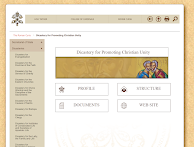Over the past two weeks we have visited three of the sixteen Dicastery Offices. Until coming to Rome I had little understanding of what a Dicastery Office was or what they did. In the past the Offices went by other names such as Pontifical Office or Secretariat, so this may contribute to why they are not in our regular vocabulary. Follow this link to find the Vatican Web page with the sixteen Dicastery Offices listed, with links to their work: https://www.vatican.va/content/romancuria/en.html
These Offices can be viewed as part of the Roman Curia or
administrative offices of the Vatican. Staffed largely by priests (although I
did see a few names of religious sisters and lay women), they complete the work
of the Vatican office, aiding the Pope in his mission, serving both the Pope
and the universal church. The office is
led by a prefect, and then supported by a secretary and under-secretary. They
put in motion, share information, express opinions on Vatican related matters. No
office has greater power than the other, or command over another office. Here
is a Vatican podcast that explains the Roman Curia in more detail: https://youtu.be/-kg0lm4DaaA
The
Dicastery for Promoting Christian Unity and Dicastery for Interreligious
Dialogue promote great work as they continue to build relationships and
dialogue with both Christians, other faiths and nonbelievers through out the
world. Both
offices have a relatively small staff, 24 and 18 respectively but the work they
do significantly impacts Catholic relationships as they seek to build mutual
understanding and unity wherever possible throughout the world.
How can we help spread the news of the good work that is done through the Dicastery Offices? Throughout our visits this question kept popping up. I must admit that I never found a clear answer, partially because this is a bureaucratic office, the information is shared from the top down, any break in the dissemination of the knowledge can result in a total loss of information. This should not stop us, those who sit in the pews from learning about what our Church is doing. Our main connection is the Vatican website. Although some links do not appear to be updated as frequently, news is published here. The Vatican has many social media links, these may not distribute documents, but it will give information on announcements. What we do with the information is key as action will be needed. As part of grassroots movements, we can reach out to our parish priest and deacons, diocesan offices or even connect at the national level. As St. Teresa of Avila stated, “Christ has no body now but yours. No hands, no feet on earth but yours. Yours are the eyes through which he looks compassion on this world.” The first step is to remain informed about the work done and information shared through the Dicastery Offices, but even more importantly, once we are informed, we need to work as a community putting into action the work of Christ. By Melinda




Comments
Post a Comment